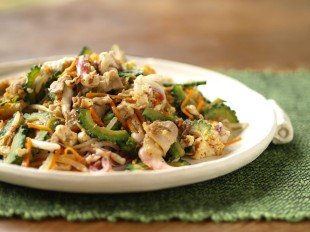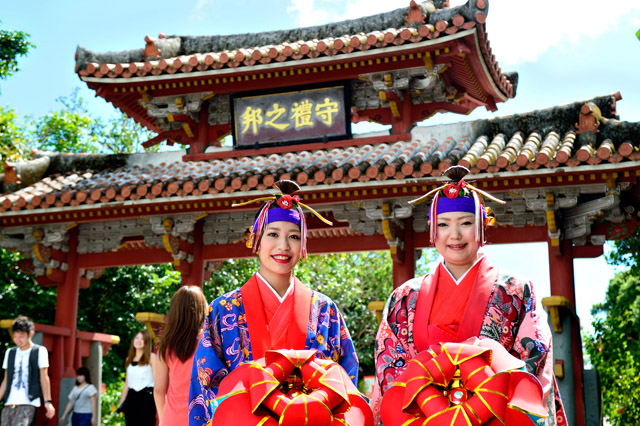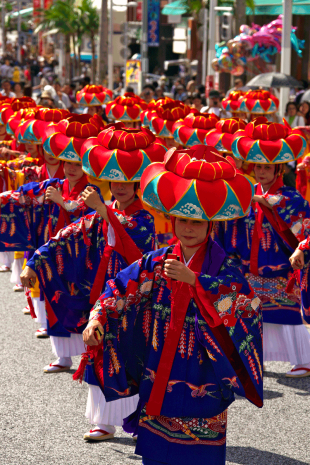Okinawa’s “Big City” of Naha serves up a mixed dish of flavors and unique cultural experiences. And the world is taking notice.
By Andy Gayler
Year-round, the islands (there are about two dozen) of Okinawa beckon the rest of Japan to come down and take a break, even though the busy cities to the north aren’t big on long breaks. However, it’s only a three-hour flight to Naha, Okinawa’s prefectural capital, for a respite from “big island” life and a gateway to more travels, if you’ve got the time. Even at its coldest, Naha’s not too bad (average temperatures around 16°C in January) and, when the sun is out, you may even be able to don T-shirt and shorts and head to one the many near-empty beaches for a paddle (or brave swim).
Mensore—“Welcome”—to Okinawa
When you arrive in Okinawa, you’re almost certain to be already arriving in Naha, either at its airport or one of its seaports (if you have the time for the 48-hour ferry journey from Tokyo), so there’s little time wasted on additional transport links and you can get straight to enjoying your escape. Of course, you could still hire a car and head elsewhere on the island, but the main city’s not a bad base while down this way on a short winter getaway, and at least if the weather is disappointing you can still find plenty to do.
At first, Naha is just another densely populated Japanese conurbation—this one with more than 300,000 inhabitants. But don’t let this sense of “been there, seen that” put you off. Naha was recently tipped by the influential TripAdvisor website as one of its ten “destinations on the rise.” And such a label is not to be taken too lightly, either. The other members of this exclusive group included lesser-heralded spots in more internationally recognized tourist destinations than Okinawa—Vietnam, Cambodia, Thailand, Cyprus, Turkey, Egypt, Russia, Israel and Brazil.
In the City
Although phrases such as “a city of contrasts” or “a city of contradictions” are travel writing clichés, Naha does still seem to combine its “contrasting” Japanese and Okinawan—and American—influences to become something slightly different to everywhere else in Japan. For a start, its most famous street, Kokusai Dori, is lined with palm trees, live venues for the island’s traditional music, and maintains a thriving, labyrinthine street market, albeit a roofed one (handy at this rainy time of year), as well as the obligatory souvenir shops selling Okinawan snacks, mini-shisa (lion dog statues similar to those in other Chinese-influenced parts of Asia) and the local tipple, awamori.
The street is unapologetically geared towards tourists, but it’s still a good place to start your tour before heading to some of the other sites in the city, such as the old pottery district around Yachimun Dori, the 18th century gardens of Shikinaen, or Shuri Castle and its related historical sites, or even exploring further afield where life does become less Japanese and increasingly Okinawan.
Out of Town
In fact, if you head out of Naha, you might actually feel as if you’ve gone abroad after all, aside from the language. This is because the prefecture, formerly (most of) the Ryukyu Kingdom, still maintains much of its own unique cultures and lifestyles despite more than a hundred years of outright control by Japan (1879–1945 and 1972 to present) and the United States (1945–1972).
Just take a look at the food. The cuisine of Okinawa is known for its unique and healthy mix of ingredients from around Asia, many of which are completely different from those on Japan’s bigger islands. Then there is the architecture—concrete is king, not wood, for house-building, and white-washed walls dominate the urban landscapes, both to protect against the seasonal typhoons and to keep things cool during the long summer.
Even the music and entertainment can boast uniqueness. Traditional performances are a thriving part of everyday life in the islands, particularly for festivals, and not just something kept alive by historical societies. You can find plenty of live venues, many with internationally acclaimed Okinawan musicians and singers, in the capital, or simply happen upon one during your travels.
And did I say the people speak Japanese? Even that’s not guaranteed. If you have the good fortune to hear two of the much older generation having a chat you may notice (presuming your Japanese skills are a bit better than beginner) that: a. you don’t understand a word they’re saying, and b. the traditional language (or “dialect,” depending on your position) hasn’t quite died out—despite a previously heavy-handed enforcement of Japanese through the education system.
It’s sadly true though, that if you want to see what that old Ryukyu Kingdom really used to look like, you may have to stretch your imagination a little. But there’s still enough to help you to do so. A number of Okinawa’s distinctive castles are spread across the island, five of which are UNESCO World Heritage Sites. Most, Nakagusuku, Katsuren, Zakimi and Nakijin, have little but the wall remains to provide evidence of the “old days,” but the capital’s Shuri Castle is a colorful reminder that it was China that initially played big brother and occasional teacher to the kingdom during its independent era. The red wooden structure is actually a replica of the original that was destroyed during the massive World War Two land battle of 1945. The site was the headquarters of the Japanese military in Okinawa during the devastating campaign and was completely leveled by US artillery fire. The story of its role in the war is worth a visit alone, but that would be to ignore the castles’ much longer, and possibly more dignified past—as the center of a successful trading kingdom. For, while Japan was playing “keepaway” with the world during the Edo period (1603–1868), its small southern neighbor was busy making friends and absorbing new ideas—creating this chanpuru (mixed) culture, as they say in Okinawa.
A Taste of Okinawa
Many of the island’s top food spots and trendiest cafes are in Naha, and the market in Heiwa Dori is a great place for a first lunch. You can buy fresh fish, or other seafood, at the first floor fish market, then have your purchase cooked upstairs in the cafeteria. Gurukun is the famous local fish, and it’s particular tasty when deep-fried Okinawa style.

A plate of goya (bitter melon) chanpuru. The fry-up, which can be made with a variety of ingredients, is a bit of a symbol of the island culture itself
Also while on the island try a bowl of hot Okinawa soba (made of wheat and not to be confused with the buckwheat soba noodles on the mainland), the tasty and healthy umi budo and mozuku seaweeds, and shimadofu (Okinawa tofu).
Then, of course, there is chanpuru, a fried dish of mixed vegetables and meat, or fu—it’s also a word sometimes also used to describe the region’s own mix of cultures and influences, which includes influences and ingredients from around Asia.
Finally, for something sweet, don’t miss the salt or benimo (sweet potato, one of Okinawa’s staple ingredients) ice creams, and try some of the satandagi, a kind of Okinawa donut, too.
This broad variety of ingredients, and a commitment to healthy living, may be part of the reason that Okinawans are known for being some of the longest-lived people on the planet.
Updated On January 30, 2023










